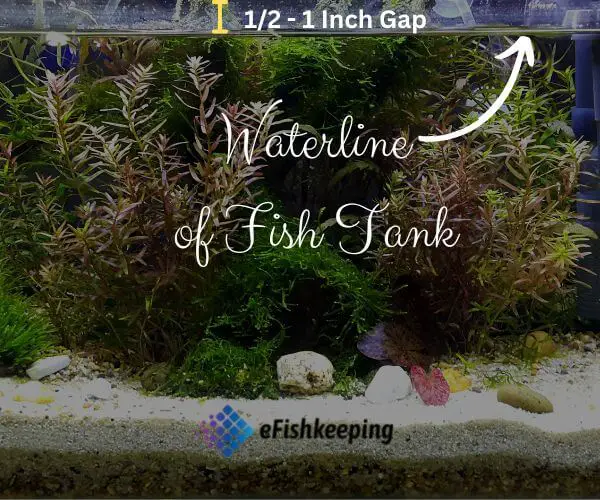When it comes to setting up and maintaining a fish tank, one of the important decisions that you’ll need to make is how high to fill the tank with water.
While it may seem like a simple task, the water level in your tank can have a big impact on the tank ecosystem. So, should you fill your fish tank up all the way? Let’s explore this question in more detail.
Should You Fill The Fish Tank Up All The Way?
| Pros | Cons |
| Tank looks good without visible waterline | Top swimmer fish can struggle |
| More water volume for the fish | Lack of proper oxygenation |
The cons of filling a fish tank all the way up outweigh the pros because the cons have more impact on the tank environment. So it’s best to leave some gap between the top of the tank and the water level.
Related Reading: Fish Tank Open Or Closed: Which Is Better?
Here’s How Much Space You Should Leave At The Top Of The Fish Tank:

As a general rule, leave a space of 1/2 to 1 inch between the top of the tank and the water level. This space is crucial for proper oxygenation, as it allows for proper surface water movement. Additionally, it provides ample room for top-swimming fish like Bettas to move and breathe comfortably.
The last thing you’d like is for your fish’s heads to bump against the top of the tank (cover or hood of the aquarium) every time they swim to the surface. Right?
Pro Tip: Keep the tank water level at the bottom rim where the tank cover sits. This way when you place the cover on top there will still be some gap between the water level and the cover. And the nice thing is, the waterline would still remain hidden behind the rim.

What Would Happen If You Fill The Fish Tank Up All The Way:
1. Lack Of Proper Oxygenation
The gap between the water level and the top of the tank is important for proper water oxygenation because oxygen enters the water primarily through the surface.
When the water level is too high and reaches the top of the tank, it can limit the amount of oxygen that gets into the water. This happens because when the water level is at the top of the tank, there is no space for the water to move and create surface agitation.
This lack of movement prevents the exchange of gasses between the water and the air, which limits the amount of oxygen that can enter the water.
2. Uncomfortable For Top Swimmer Fish

Another issue that can arise when filling a fish tank all the way to the top is that it can be uncomfortable for the fish that are top swimmers.
Fish have natural swimming patterns, and some tend to remain at the top of the tank more often than others. If the water level is too high, it can limit their ability to swim comfortably. This can eventually lead to stress in some fish.
Fish like bettas and cory catfish often swim to the top of the tank, to take a gulp of air. So you need to ensure there is at least a slight gap present so that they can maneuver themselves comfortably.
Recommended Read: The Best Sponge Filters You Should Have For Betta Fish!
Should A Fish Tank Filter Be Fully Submerged?
| Filters That Need To Be Submerged: | Filters That Don’t Need To Be Submerged: |
| Sponge Filter | Top Filter |
| Undergravel Filter | Hang On Back filter |
| Internal Filter | Canister Filter |
1. Water Level For Sponge Filters
Sponge filters in aquariums are a great way to keep your tank clean and your fish healthy. These filters work by using a porous sponge material to trap debris and other contaminants in the water.
The sponge filter is connected to an air pump, which creates bubbles that flow through the sponge. As the bubbles move through the sponge, they create a suction effect that pulls water into the filter.
Inside the sponge filter, there are also beneficial bacteria that live and grow, these bacteria help to break down harmful ammonia and nitrite, which are produced by fish waste and other organic matter. This helps to keep the water in your tank clean and healthy for your fish.
Sponge filters can be placed anywhere in the tank, as long as they are connected to an air pump. This means that you can place them in a location that works best for you and your fish.
But remember, sponge filters do need to be submerged to work properly regardless of the location you choose.
The suction force is created when air (from air pump) moves through the sponge filter and water gets pulled into the filter through the sponge walls.
If the sponge filter is not submerged in water, the dirt particles couldn’t be cleaned.
See Related: How Often Should You Clean Sponge Filters?
2. Water Level For Hang On Back filter
A hang-on-back filter, also known as a HOB filter, is a type of filter that hangs on the back of an aquarium. This type of filter is easy to install and maintain, making it a popular choice among fish tank enthusiasts.
HOB filters work by pulling water from the tank through an intake tube and then pushing it through a filter media, such as activated carbon, ceramic rings, or bio-balls, that removes debris, and other contaminants from the water. The cleaned water then flows back into the tank through the outlet area.
As long as there is some space (height) between the outlet area from where the water falls into the tank – you are good to go.
In general, keep an inch or half-inch gap from the outlet of the HOB filter to the water line. This will ensure the water falls through the Hang on back filter’s outlet area into the tank and creates water movement – and helps in oxygenation.
Related Read: Why Is My Whisper Filter Making Noise?
Wrapping Up
In short, when it comes to filling a fish tank, it is important to consider the impact that the water level has on the tank ecosystem.
Filling the tank all the way up can lead to lack of proper oxygenation and discomfort for top-swimming fish.
It is recommended to leave a gap of 1/2 to 1 inch between the top of the tank and the water level to ensure proper oxygenation and comfortable swimming space for your fish.
Additionally, it’s important to note that certain types of filters (like Sponge Filters) need to be fully submerged while others (like HOB filters) need to be hung on the tank wall.
Ultimately, the goal is to create a healthy and comfortable environment for your fish, and paying attention to water level is an important aspect of achieving that goal.
Read Next: Fluval 407 Canister Filter Review: Is It For You?
Hi! I’m Praveen Ghoshal, the founder of eFishkeeping.com. Inspired by my Dad, I got interested in fishkeeping when I was a kid. Since then, I have been involved with this hobby. Currently, I have 3 fish tanks at our home, and I enjoy this hobby with my full family. Read more about me here.







